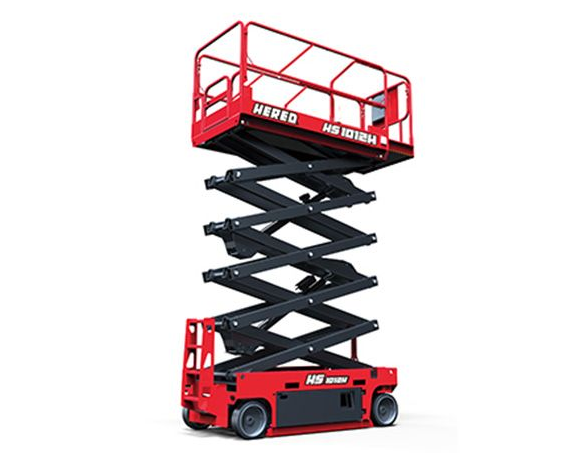Common Indoor Overhead Hazards for Scissor Lifts
Scissor lifts enable users to reach high areas indoors, and they are often used in hospitals, schools, hotels, and other worksites with high ceilings. At industrial worksites, scissor lifts can be used for installing or replacing overhead lighting or HVAC piping.
Small scissor lifts for indoor use are commonly used for tasks such as painting, damage repair, and various maintenance activities. Warehouse workers often utilize them to access high shelves for inventory checks.
Ultimately, scissor lifts are among the safest aerial lifts, offering versatility and ease of use. Their small footprint makes them ideal for warehouses and other indoor locations with limited space. Additional reasons for their frequent use include:
Advantages of Scissor Lifts
- Stability: The stable base allows scissor lifts to operate on various surfaces.
- Size: Their compact design enables easy maneuverability in narrow aisles and crowded areas.
- Fall Protection: Enclosed platforms help prevent falls and provide secure handholds for workers in the air.
- Work Area: Scissor lifts offer more working space than many other aerial lifts, allowing operators to easily handle tools and equipment.
While scissor lifts have many advantages, operators must be aware of overhead hazards. Understanding these risks helps manage potential dangers and reduce the likelihood of on-the-job accidents and injuries.
A Closer Look at Overhead Work Hazards
The most significant risk associated with indoor scissor lifts is workers falling from the platform. When used indoors, overhead hazards pose another major concern.
Accidental contact with overhead hazards is a leading cause of workplace injuries. Common overhead work hazards include:
- Low ceilings
- Large beams and rafters
- HVAC ducts and piping
- Ceiling fans and air conditioning conduits
- Electrical cables or wiring
- Indoor lighting
- Permanent scaffolding and railings
- Overhead signage
- Cluttered work areas
Addressing overhead work hazards is essential, and educating your workers about them can significantly reduce the risk of accidents.
Accidents related to overhead hazards typically occur for three main reasons:
1. Using the Wrong Lift: A scissor lift’s maximum height should not exceed the ceiling height. If the platform is raised too high, workers risk being crushed against the ceiling.
2. Incorrect Setup: Scissor lifts must be locked into place before raising the platform and while working at height. If the lift shifts while the platform is elevated, workers may inadvertently come into contact with overhead hazards.
3. Inattentive Operator: Indoor tasks often involve working near overhead hazards. When workers are not fully focused on their tasks, they become more vulnerable to accidents caused by these hazards.
Overhead hazards pose risks to both scissor lift operators and bystanders in construction and other industries. However, with comprehensive safety training, workers can identify and mitigate risks before they escalate. This training also helps them choose the most suitable scissor lift for any worksite at any time.
Want to Eliminate Overhead Hazards in Construction and Other Industries? Choose the Right Scissor Lift
The first step in ensuring scissor lift safety is selecting the appropriate lift for your worksite. Scissor lifts come in various sizes and types; some are compact and easy to maneuver, while others are designed for heavier loads. Using the wrong lift can hinder productivity and endanger workers.
Start by assessing worksite conditions and identifying potential risks, including the nature of the job and its location. Consider any equipment that will be used on the platform and any overhead hazards that may be present.
Next, determine the maximum height workers need to reach, ensuring the lift does not exceed your indoor ceiling height. Evaluate the lift's size as well—larger lifts may have difficulty navigating small entrances, narrow doorways, or crowded aisles.
Choose a lift that allows for easy access and maneuverability within your worksite. If storage space is limited, consider the lift's dimensions to ensure safe storage.
Weight capacity is another critical factor. Assess how much weight the scissor lift needs to support, including the number of workers and any heavy equipment on the platform.
Also, evaluate the type of flooring. Ensure the surface can safely support the lift’s weight, as self-propelled scissor lifts can damage sensitive flooring or cause tiles to crack.
Finally, consider the lift’s power source. Liquid fuel lifts can emit harmful fumes indoors, while battery-powered lifts provide a safer alternative.
Take your time when evaluating scissor lifts; prioritizing worker safety will help you select a lift that enables employees to complete their tasks efficiently and safely.
Scissor Lift Safety Tips to Address OSHA Overhead Hazards
Once you have the right scissor lift for the job, there are several key safety practices to follow:
- Inspect the Lift: Always conduct a thorough inspection before use.
- Use Safety Harnesses: Ensure that all workers on the platform wear safety harnesses.
- Avoid Moving While Elevated: Do not move the lift with the platform raised.
- Watch for Overhead Obstructions: Exercise caution when raising the lift near overhead hazards.
Most importantly, all scissor lift operators must be fully trained and certified. This training ensures that operators understand how to protect themselves and others from OSHA overhead hazards and other workplace dangers.





